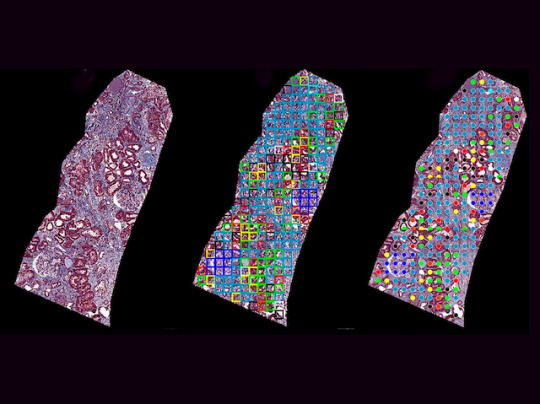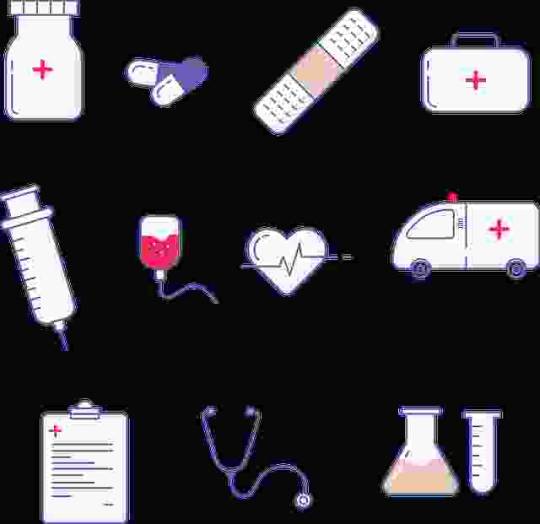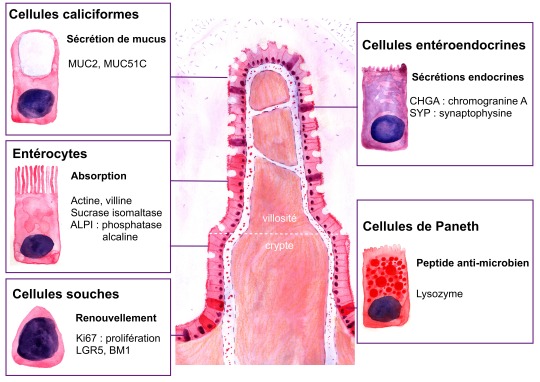#biopsies
Explore tagged Tumblr posts
Text

Computing Kidneys
Analysing kidney biopsies using a novel approach with unsupervised machine learning algorithms accurately classifies chronic kidney disease and predicts future kidney function
Read the published research paper here
Image from work by Joonsang Lee and colleagues
Department of Computational Medicine and Bioinformatics and Department of Pathology, University of Michigan, Ann Arbor, MI, USA
Image originally published with a Creative Commons Attribution 4.0 International (CC BY 4.0)
Published in Scientific Reports, August 2023
You can also follow BPoD on Instagram, Twitter and Facebook
#science#biomedicine#kidneys#chronic kidney disease#kidney function#renal#histology#biopsies#machine learning#algorithms
9 notes
·
View notes
Text
UK hospitals begin live trial of prostate cancer-detecting AI
New Post has been published on https://thedigitalinsider.com/uk-hospitals-begin-live-trial-of-prostate-cancer-detecting-ai/
UK hospitals begin live trial of prostate cancer-detecting AI
.pp-multiple-authors-boxes-wrapper display:none; img width:100%;
Three hospital systems across England have begun a live clinical trial of AI technology designed to detect and grade prostate cancer. The study – known as ARTICULATE PRO – is being led by the University of Oxford in collaboration with Paige, a pioneer in clinical AI applications for cancer diagnosis.
The participating hospitals – North Bristol Trust Southmead Hospital, University Hospitals Coventry and Warwickshire, and Oxford University NHS Foundation Trust – are now incorporating Paige’s AI technology into their standard of care. This multisite trial aims to evaluate the potential of AI to improve patient outcomes against a backdrop of rising prostate cancer cases.
Professor Clare Verrill, OUH Cellular Pathology Consultant, Associate Professor and Principal Investigator of ARTICULATE PRO, said “The central focus of ARTICULATE PRO is patients. We are striving towards our goal to safely and effectively ensure they benefit the most from powerful AI technology.
“With the multisite live use of The Paige Prostate Suite, we can systematically study benefits to patients in clinical settings.”
The Prostate Suite – the AI system being trialled – is designed to assist pathologists in detecting, grading, and measuring tumours in prostate biopsies and tissue samples. Pathologists at the three hospitals are assessing how this AI technology impacts their clinical decision-making, pathology service delivery, and resource utilisation in real-world settings.
Dr Jon Oxley, Uropathologist and Bristol lead of ARTICULATE PRO, commented: “I have studied the disease and progression of prostate cancer in clinical research for over 25 years, it is a significant advancement that Paige’s AI applications have achieved a level of validation and performance that allows safe and effective live clinical use.
“Using Paige Prostate Suite alongside our standard of care has the promise to increase efficiency and improve reproducibility of results for patients.”
The study is notable for its implementation across hospitals using different digital pathology scanners and information systems, serving distinct patient populations. This diversity allows for a comprehensive assessment of how Paige’s AI technology can best serve patients, histopathologists, and hospital systems in prostate cancer diagnosis.
Dr Bidisa Sinha, Uropathologist at University Hospitals Coventry and Warwickshire, added: “We believe AI can help to improve the accuracy and consistency of grading cancer and assist in detection of small areas of cancer which are easy to miss.
“This is world-leading research being carried out at UHCW. We are proud to be a global leader in the field of digital and computational pathology.”
The ARTICULATE PRO study is funded by the Accelerated Access Collaborative (AAC) Artificial Intelligence in Health and Care Award, overseen by the Department of Health and Social Care.
As prostate cancer rates continue to rise, the integration of AI in diagnosis could potentially lead to earlier detection, more accurate grading, and ultimately improved patient outcomes. The results of this trial could pave the way for wider adoption of AI in cancer diagnosis across the UK and beyond.
(Image Credit: Paige)
See also: AI could unleash £119 billion in UK productivity
Want to learn more about AI and big data from industry leaders? Check out AI & Big Data Expo taking place in Amsterdam, California, and London. The comprehensive event is co-located with other leading events including Intelligent Automation Conference, BlockX, Digital Transformation Week, and Cyber Security & Cloud Expo.
Explore other upcoming enterprise technology events and webinars powered by TechForge here.
Tags: ai, articulate pro, artificial intelligence, cancer, health, healthcare, nhs, paige, prostate cancer, prostate suite
#ai#ai & big data expo#amp#applications#Articles#articulate pro#artificial#Artificial Intelligence#assessment#automation#Big Data#billion#biopsies#bristol#Cancer#cancer diagnosis#clinical research#Cloud#Collaboration#collaborative#Companies#comprehensive#conference#cyber#cyber security#data#detection#Digital Transformation#Disease#diversity
0 notes
Text

The Significance of Biopsies in Preventative Healthcare:
Historically, biopsies have primarily been used to diagnose suspected illnesses or track known ailments. Nevertheless, their utilization in preventive healthcare has been constrained. By integrating biopsies into routine health screenings, healthcare providers gain access to extensive insights into an individual's cellular health, facilitating the early detection of abnormalities prior to clinical manifestation. Biopsies offer valuable information on genetic predispositions, tissue microenvironment, biomarker discovery, and monitoring treatment response, thereby facilitating tailored preventive measures and enhancing patient outcomes.
1. Genetic Susceptibility: Biopsies uncover genetic mutations or variances that predispose individuals to specific diseases, such as cancer or autoimmune disorders. Early identification of these genetic indicators enables targeted interventions and personalized preventive measures. With advancements in genomic sequencing technologies, biopsies now play a crucial role in understanding an individual's genetic makeup, facilitating proactive steps to mitigate disease risks.
2. Cellular Environment: The cellular microenvironment captured through biopsies provides crucial insights into inflammation, oxidative stress, and tissue restructuring. Changes in the tissue microenvironment often precede clinical signs of disease, making them valuable indicators for early detection and intervention. Through analysis of biopsy samples, healthcare providers can identify subtle alterations indicative of disease onset or progression, enabling timely interventions to halt or mitigate disease advancement.
3. Biomarker Discovery: Examination of biopsy samples aids in identifying specific biomarkers associated with disease risk or progression. These biomarkers serve as early warning signs of disease and inform proactive management strategies. From circulating tumor cells in cancer patients to cardiac biomarkers in individuals at risk of cardiovascular disease, biopsies offer a glimpse into the molecular landscape of health and disease, empowering healthcare providers to intervene preemptively.
4. Monitoring Treatment Response: For individuals undergoing treatment for chronic conditions like cancer, biopsies serve as invaluable tools for monitoring treatment response at the cellular level. Real-time assessment of treatment effectiveness and disease progression permits adjustments in treatment protocols to optimize outcomes and minimize adverse effects. Additionally, biopsies enable the identification of treatment-resistant cell subpopulations, guiding the selection of alternative therapeutic approaches for improved patient outcomes.
There are many good hospitals in India that offer health checkup packages to undergo regular health checkups. You can choose a full body health checkup that may or may not include biopsy depending on your individual health needs and doctor's recommendations.
#full body health checkup#regular health checkups#health checkup packages#biopsy#biopsies#biomarkers#genetic susceptibility
0 notes
Text
0 notes
Text
Noah Medical has received $150 million in venture capital funding for its lung biopsy robot

- By InnoNurse Staff -
The Silicon Valley-based company raised $150 million to assist in the development of a commercial engine for its Galaxy system, which is designed to do guided lung bronchoscopies with disposable probes.
Read more at Fierce Biotech
///
Other recent news and insights
How AI is being used by healthcare informatics leaders (Becker’s Health IT)
Athenahealth introduces a new tool to assess patient engagement with digital health (Fierce Healthcare)
Segmed, NVIDIA, and RadImageNet launch synthetic medical imaging data generative AI initiative (Segmed/PRNewswire)
AI is being used by researchers to better identify the weaknesses of lung cancer cells (University of Montana)
A bioinformatic investigation of the perivascular area uncovers 24 genetic risk loci (Medical Xpress)
Tricog Health, an Indian healthtech startup, has raised $8.5 million (The Economic Times)
#biopsies#lung#lungs#robots#robot#robotics#health tech#digital health#medtech#health it#ai#artificial intelligence#health informatics#athenahealth#segmed#nvidia#RadImageNet#generative ai#cancer#oncology#genomics#bioinformatics#brain#neuroscience#cardiology#chronic condition#noah medical
0 notes
Text










|L|I|N|E|S|
#house md#acontextual house#james wilson#gregory house#allison cameron#eric foreman#robert chase#remy hadley#thirteen#13#martha m. masters#lisa cuddy#stopping the biopsy to play some tunes~#hardest thing about these is double checking if i already posted particular cap or not#“ive been thinking about this and theres no way i didnt include this already” - i didnt - often
689 notes
·
View notes
Text











Sale post! Very sorry for the photo quality on some of these, I can attempt to take more if you're interested in a piece and ask for different angles/lighting.
Deinonychus is $350, hangs out from the wall 21 inches and is 19 inches tall
Yi qi is $180, 11 inches long and 8 tall
Catfish is $350, 15 inches long and 17 tall
Tianyulong is $200, 29 inches long and 11 tall, the tail is poseable
Fur-bearing golden trout is $130, 12 inches long
#taking horrible phone photos to try and raise funds to fix or replace my real camera#hell situation#sculpture#for sale#yi qi#Tianyulong#fantasy#faux taxidermy#cryptid#raptor#Deinonychus#also need to take the puppy to the vet for a biopsy on Wednesday to find out if his mouth tumor is malignant#it's possible my hiking buddy is going to be a rather short term companion#everything happens so much
429 notes
·
View notes
Text
.
#waiting to drive large bastard to the hospital for an emergency biopsy#apparently some testing stuff hasn't gone well this week#and there are symptoms of rejection#nothing to panic about because steps at this point are testing and meds adjustment#but that means we're just both sitting around feeling pre-dread
211 notes
·
View notes
Text
my dad said today feels like waiting for the results of a biopsy
#election 2024#and i couldn’t agree more#actually made me feel a bit better?#bc i’ve waited for biopsy results before#i have a script for that#it still sucks but at least it’s more familiar that whatever the fuck is happening with the election
63 notes
·
View notes
Video
tumblr
Look and Listen
There are many tools at doctors’ fingertips to diagnose non-alcoholic fatty liver disease – a very common condition – including ultrasound, MRI and CT scans, and biopsy. But each of these have drawbacks, ranging from expense and risk (particularly in biopsies) to unsuitability for patients with certain implants (MRI scanning). So researchers are exploring non-invasive alternatives such as photoacoustic tomography (PAT). PAT uses both light and sound waves to generate detailed images, interpreting ultrasound waves given off by structures when laser light is fired onto them. Previously, the technology couldn’t visualise blood vessel detail and movement, but a new iteration, 3D-PAT, overcomes those limitations to precisely reveal liver vessel volume, number, and distribution (as seen in this video) while carefully correcting for the natural movement caused by regular breathing. They used the technique to compare structural differences between obese and lean rats, and hope this approach could ultimately provide quick, safe information for doctors and patients.
Written by Anthony Lewis
Video from work by Xin Tong and colleagues
Caltech Optical Imaging Laboratory, Andrew and Peggy Cherng Department of Medical Engineering, Department of Electrical Engineering, California Institute of Technology, Pasadena, CA, USA
Video originally published with a Creative Commons Attribution 4.0 International (CC BY 4.0)
Published in Advanced Science, November 2022
You can also follow BPoD on Instagram, Twitter and Facebook
#science#biomedicine#non-alcoholic fatty liver disease#liver#diagnostics#photoacoustic tomography#ultrasound#mri#ct scan#biopsies
8 notes
·
View notes
Text

#kirby#gif#ask to tag#daily kirby#my art#digital#hal laboratory#nintendo#it's another Day#every day has been A Day#I feel like a mouse scrabbling around trying to get out of my own brain#(or out of my own body I suppose since that's the primary culprit)#the biopsy is tomorrow and then another 2 weeks for the results.#and then who knows how long for proper treatment - depends on the results
296 notes
·
View notes
Text
Researchers Improve Blood Tests’ Ability to Detect and Monitor Cancer - Technology Org
New Post has been published on https://thedigitalinsider.com/researchers-improve-blood-tests-ability-to-detect-and-monitor-cancer-technology-org/
Researchers Improve Blood Tests’ Ability to Detect and Monitor Cancer - Technology Org
Tumors constantly shed DNA from dying cells, which briefly circulates in the patient’s bloodstream before it is quickly broken down. Many companies have created blood tests that can pick out this tumor DNA, potentially helping doctors diagnose or monitor cancer or choose a treatment.
A blood test procedure. Image credit: Max Pixel, CC0 Public Domain
The amount of tumor DNA circulating at any given time, however, is extremely small, so it has been challenging to develop tests sensitive enough to pick up that tiny signal. A team of researchers from MIT and the Broad Institute of MIT and Harvard has now come up with a way to significantly boost that signal, by temporarily slowing the clearance of tumor DNA circulating in the bloodstream.
The researchers developed two different types of injectable molecules that they call “priming agents,” which can transiently interfere with the body’s ability to remove circulating tumor DNA from the bloodstream. In a study of mice, they showed that these agents could boost DNA levels enough that the percentage of detectable early-stage lung metastases leapt from less than 10 percent to above 75 percent.
This approach could enable not only earlier diagnosis of cancer, but also more sensitive detection of tumor mutations that could be used to guide treatment. It could also help improve detection of cancer recurrence.
“You can give one of these agents an hour before the blood draw, and it makes things visible that previously wouldn’t have been. The implication is that we should be able to give everybody who’s doing liquid biopsies, for any purpose, more molecules to work with,” says Sangeeta Bhatia, the John and Dorothy Wilson Professor of Health Sciences and Technology and of Electrical Engineering and Computer Science at MIT, and a member of MIT’s Koch Institute for Integrative Cancer Research and the Institute for Medical Engineering and Science.
Bhatia is one of the senior authors of the new study, along with J. Christopher Love, the Raymond A. and Helen E. St. Laurent Professor of Chemical Engineering at MIT and a member of the Koch Institute and the Ragon Institute of MGH, MIT, and Harvard and Viktor Adalsteinsson, director of the Gerstner Center for Cancer Diagnostics at the Broad Institute.
Carmen Martin-Alonso PhD ’23, MIT and Broad Institute postdoc Shervin Tabrizi, and Broad Institute scientist Kan Xiong are the lead authors of the paper, which appears today in Science.
Better biopsies
Liquid biopsies, which enable detection of small quantities of DNA in blood samples, are now used in many cancer patients to identify mutations that could help guide treatment. With greater sensitivity, however, these tests could become useful for far more patients. Most efforts to improve the sensitivity of liquid biopsies have focused on developing new sequencing technologies to use after the blood is drawn.
While brainstorming ways to make liquid biopsies more informative, Bhatia, Love, Adalsteinsson, and their trainees came up with the idea of trying to increase the amount of DNA in a patient’s bloodstream before the sample is taken.
“A tumor is always creating new cell-free DNA, and that’s the signal that we’re attempting to detect in the blood draw. Existing liquid biopsy technologies, however, are limited by the amount of material you collect in the tube of blood,” Love says. “Where this work intercedes is thinking about how to inject something beforehand that would help boost or enhance the amount of signal that is available to collect in the same small sample.”
The body uses two primary strategies to remove circulating DNA from the bloodstream. Enzymes called DNases circulate in the blood and break down DNA that they encounter, while immune cells known as macrophages take up cell-free DNA as blood is filtered through the liver.
The researchers decided to target each of these processes separately. To prevent DNases from breaking down DNA, they designed a monoclonal antibody that binds to circulating DNA and protects it from the enzymes.
“Antibodies are well-established biopharmaceutical modalities, and they’re safe in a number of different disease contexts, including cancer and autoimmune treatments,” Love says. “The idea was, could we use this kind of antibody to help shield the DNA temporarily from degradation by the nucleases that are in circulation? And by doing so, we shift the balance to where the tumor is generating DNA slightly faster than is being degraded, increasing the concentration in a blood draw.”
The other priming agent they developed is a nanoparticle designed to block macrophages from taking up cell-free DNA. These cells have a well-known tendency to eat up synthetic nanoparticles.
“DNA is a biological nanoparticle, and it made sense that immune cells in the liver were probably taking this up just like they do synthetic nanoparticles. And if that were the case, which it turned out to be, then we could use a safe dummy nanoparticle to distract those immune cells and leave the circulating DNA alone so that it could be at a higher concentration,” Bhatia says.
Earlier tumor detection
The researchers tested their priming agents in mice that received transplants of cancer cells that tend to form tumors in the lungs. Two weeks after the cells were transplanted, the researchers showed that these priming agents could boost the amount of circulating tumor DNA recovered in a blood sample by up to 60-fold.
Once the blood sample is taken, it can be run through the same kinds of sequencing tests now used on liquid biopsy samples. These tests can pick out tumor DNA, including specific sequences used to determine the type of tumor and potentially what kinds of treatments would work best.
Early detection of cancer is another promising application for these priming agents. The researchers found that when mice were given the nanoparticle priming agent before blood was drawn, it allowed them to detect circulating tumor DNA in blood of 75 percent of the mice with low cancer burden, while none were detectable without this boost.
“One of the greatest hurdles for cancer liquid biopsy testing has been the scarcity of circulating tumor DNA in a blood sample,” Adalsteinsson says. “It’s thus been encouraging to see the magnitude of the effect we’ve been able to achieve so far and to envision what impact this could have for patients.”
After either of the priming agents are injected, it takes an hour or two for the DNA levels to increase in the bloodstream, and then they return to normal within about 24 hours.
“The ability to get peak activity of these agents within a couple of hours, followed by their rapid clearance, means that someone could go into a doctor’s office, receive an agent like this, and then give their blood for the test itself, all within one visit,” Love says. “This feature bodes well for the potential to translate this concept into clinical use.”
The researchers have launched a company called Amplifyer Bio that plans to further develop the technology, in hopes of advancing to clinical trials.
“A tube of blood is a much more accessible diagnostic than colonoscopy screening or even mammography,” Bhatia says. “Ultimately, if these tools really are predictive, then we should be able to get many more patients into the system who could benefit from cancer interception or better therapy.”
Written by Anne Trafton
Source: Massachusetts Institute of Technology
You can offer your link to a page which is relevant to the topic of this post.
#antibodies#approach#biopsies#Biotechnology news#blood#blood tests#bloodstream#Broad Institute#Cancer#cancer cells#cell#Cells#chemical#Chemical engineering#colonoscopy#Companies#computer#Computer Science#detection#diagnostics#Disease#DNA#engineering#enzymes#Featured life sciences news#form#Health#Health & medicine news#Health sciences and technology#how
0 notes
Text


61 notes
·
View notes
Text

I finally got the results of the biopsy of a suspicious area in my breast and thankfully, it is fine. It was a benign adenoma, so nothing to worry about. I really didn't think it would be anything, for some reason, I just knew. Anyway, I wish I could figure out my camera settings, because my pictures always look blurry. 😘❤️🌹
10/28/2024
52 notes
·
View notes
Text



#I am fine needle aspirating him and shipping him off to idexx for a biopsy#sorry im running out of things to say I guess#Eddie diaz#eddiediazedit#911edit#911#911verse#🪐#my gifs
326 notes
·
View notes
Text


wish me luck for my presentation /exam
#i went a bit over the top i really didnt had to paint#but painting made my hangover way better than just studying#its for the intro of an article about Intestine on Chips#they cocultured human cells from biopsies on chips - like electronic chips !!#honestly fascinating#histology#medecine#medblr#science#biology#watercolor#gastroenterology#digestive system#studyblr#scientific illustration
151 notes
·
View notes